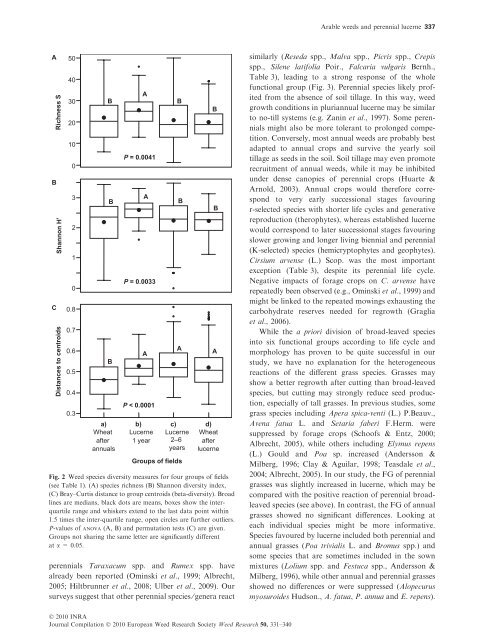Diversifying crop rotations with temporary grasslands - Université de ...
Diversifying crop rotations with temporary grasslands - Université de ...
Diversifying crop rotations with temporary grasslands - Université de ...
You also want an ePaper? Increase the reach of your titles
YUMPU automatically turns print PDFs into web optimized ePapers that Google loves.
A<br />
Richness S<br />
B<br />
Shannon H’<br />
C<br />
Distances to centroids<br />
50<br />
40<br />
30<br />
20<br />
10<br />
0<br />
3<br />
2<br />
1<br />
0<br />
0.8<br />
0.7<br />
0.6<br />
0.5<br />
0.4<br />
0.3<br />
B<br />
B<br />
B<br />
a)<br />
Wheat<br />
after<br />
annuals<br />
P = 0.0041<br />
P = 0.0033<br />
P < 0.0001<br />
b)<br />
Lucerne<br />
1 year<br />
c)<br />
Lucerne<br />
2–6<br />
years<br />
Groups of fields<br />
d)<br />
Wheat<br />
after<br />
lucerne<br />
Fig. 2 Weed species diversity measures for four groups of fields<br />
(see Table 1). (A) species richness (B) Shannon diversity in<strong>de</strong>x,<br />
(C) Bray–Curtis distance to group centroids (beta-diversity). Broad<br />
lines are medians, black dots are means, boxes show the interquartile<br />
range and whiskers extend to the last data point <strong>with</strong>in<br />
1.5 times the inter-quartile range, open circles are further outliers.<br />
P-values of ANOVA (A, B) and permutation tests (C) are given.<br />
Groups not sharing the same letter are significantly different<br />
at a = 0.05.<br />
perennials Taraxacum spp. and Rumex spp. have<br />
already been reported (Ominski et al., 1999; Albrecht,<br />
2005; Hiltbrunner et al., 2008; Ulber et al., 2009). Our<br />
surveys suggest that other perennial species ⁄ genera react<br />
A<br />
A<br />
A<br />
Ó 2010 INRA<br />
Journal Compilation Ó 2010 European Weed Research Society Weed Research 50, 331–340<br />
B<br />
B<br />
A<br />
B<br />
B<br />
A<br />
Arable weeds and perennial lucerne 337<br />
similarly (Reseda spp., Malva spp., Picris spp., Crepis<br />
spp., Silene latifolia Poir., Falcaria vulgaris Bernh.,<br />
Table 3), leading to a strong response of the whole<br />
functional group (Fig. 3). Perennial species likely profited<br />
from the absence of soil tillage. In this way, weed<br />
growth conditions in pluriannual lucerne may be similar<br />
to no-till systems (e.g. Zanin et al., 1997). Some perennials<br />
might also be more tolerant to prolonged competition.<br />
Conversely, most annual weeds are probably best<br />
adapted to annual <strong>crop</strong>s and survive the yearly soil<br />
tillage as seeds in the soil. Soil tillage may even promote<br />
recruitment of annual weeds, while it may be inhibited<br />
un<strong>de</strong>r <strong>de</strong>nse canopies of perennial <strong>crop</strong>s (Huarte &<br />
Arnold, 2003). Annual <strong>crop</strong>s would therefore correspond<br />
to very early successional stages favouring<br />
r-selected species <strong>with</strong> shorter life cycles and generative<br />
reproduction (therophytes), whereas established lucerne<br />
would correspond to later successional stages favouring<br />
slower growing and longer living biennial and perennial<br />
(K-selected) species (hemicryptophytes and geophytes).<br />
Cirsium arvense (L.) Scop. was the most important<br />
exception (Table 3), <strong>de</strong>spite its perennial life cycle.<br />
Negative impacts of forage <strong>crop</strong>s on C. arvense have<br />
repeatedly been observed (e.g., Ominski et al., 1999) and<br />
might be linked to the repeated mowings exhausting the<br />
carbohydrate reserves nee<strong>de</strong>d for regrowth (Graglia<br />
et al., 2006).<br />
While the a priori division of broad-leaved species<br />
into six functional groups according to life cycle and<br />
morphology has proven to be quite successful in our<br />
study, we have no explanation for the heterogeneous<br />
reactions of the different grass species. Grasses may<br />
show a better regrowth after cutting than broad-leaved<br />
species, but cutting may strongly reduce seed production,<br />
especially of tall grasses. In previous studies, some<br />
grass species including Apera spica-venti (L.) P.Beauv.,<br />
Avena fatua L. and Setaria faberi F.Herm. were<br />
suppressed by forage <strong>crop</strong>s (Schoofs & Entz, 2000;<br />
Albrecht, 2005), while others including Elymus repens<br />
(L.) Gould and Poa sp. increased (An<strong>de</strong>rsson &<br />
Milberg, 1996; Clay & Aguilar, 1998; Teasdale et al.,<br />
2004; Albrecht, 2005). In our study, the FG of perennial<br />
grasses was slightly increased in lucerne, which may be<br />
compared <strong>with</strong> the positive reaction of perennial broadleaved<br />
species (see above). In contrast, the FG of annual<br />
grasses showed no significant differences. Looking at<br />
each individual species might be more informative.<br />
Species favoured by lucerne inclu<strong>de</strong>d both perennial and<br />
annual grasses (Poa trivialis L. and Bromus spp.) and<br />
some species that are sometimes inclu<strong>de</strong>d in the sown<br />
mixtures (Lolium spp. and Festuca spp., An<strong>de</strong>rsson &<br />
Milberg, 1996), while other annual and perennial grasses<br />
showed no differences or were suppressed (Alopecurus<br />
myosuroi<strong>de</strong>s Hudson., A. fatua, P. annua and E. repens).

















